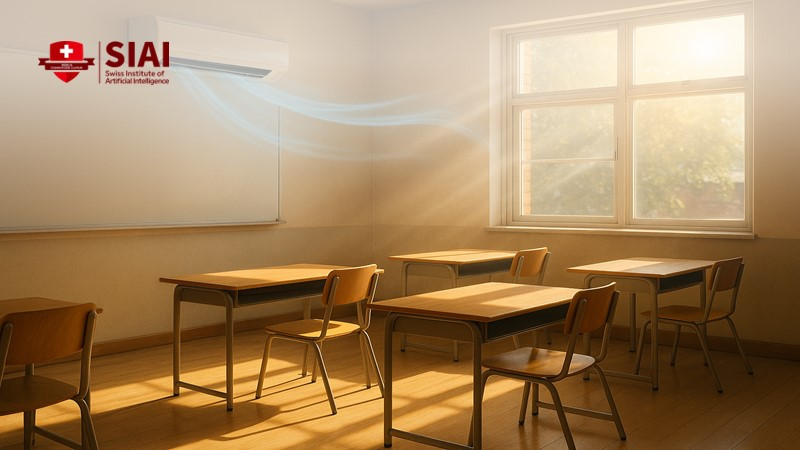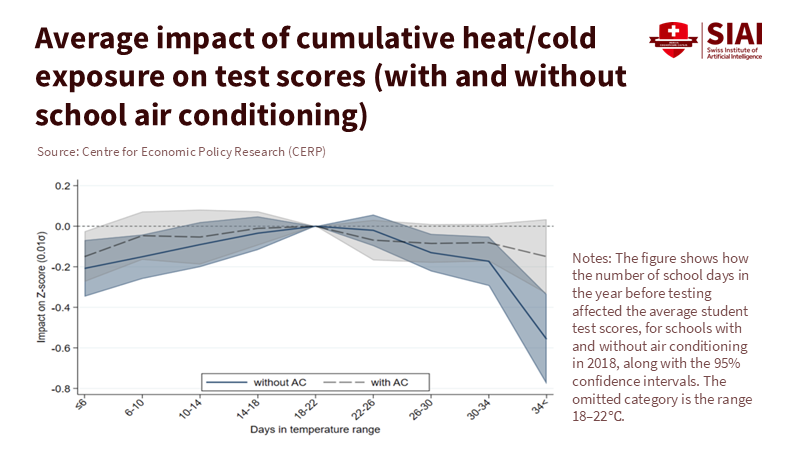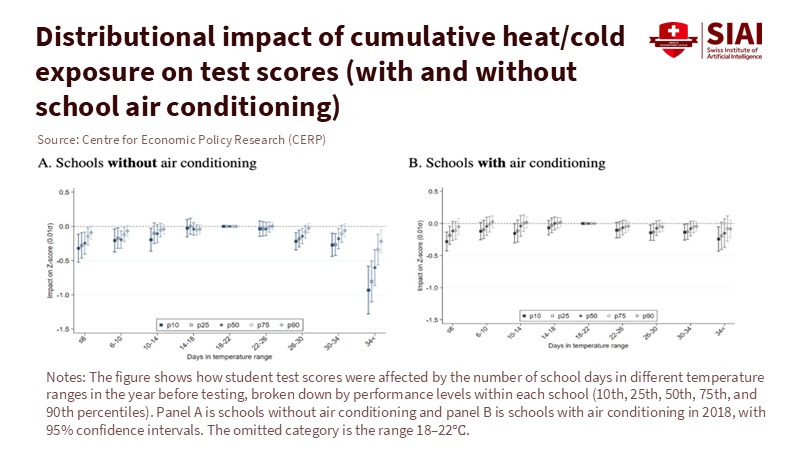Cooler Classrooms, Cooler Heads? Why Air Conditioning Alone Won’t Fix Learning
Input
Modified
Cooling classrooms cuts heat-related learning loss but doesn’t reverse falling math scores Pair AC with ventilation, phone-off rules, and morning math blocks for bigger gains Treat HVAC as a policy for instruction and track outcomes to fund what truly boosts achievement

Every policy debate needs a solid number to ground the discussion. Here is one example: according to nationwide exam data from Japan, each extra school day above 34°C was linked to a 0.56 standard deviation drop in scores if the classroom did not have air conditioning. With air conditioning, that loss decreased by about 73%. This is a significant improvement for learning during heat stress. Between 2006 and 2018, the percentage of regular classrooms equipped with air conditioning increased from approximately 10% to 50%. By 2024, nearly all public schools had air conditioning. These represent significant strides in controlling classroom temperature and promoting student well-being. However, during the same time, international performance trends worsened. Across the OECD, mathematics scores dropped by around 15 points from 2018 to 2022. Korea's average in 2022 was 527, significantly lower than its 554 in 2012, even though it remains world-class. While cooling helps maintain focus in hot classrooms, it does not, by itself, counteract global declines. The climate issue is serious. The learning issue is even more pressing.
We are now seeing policy changes. New York State has set 88°F (31.1°C) as the maximum temperature for classrooms, with removal plans in place if the temperature exceeds this limit. In the UK, there is currently no legal maximum temperature in schools; instead, guidance emphasizes risk assessment and comfort levels, rather than a strict cap. These changes will reduce heat-related illnesses and make days more manageable during heat waves. They will not automatically lead to better test scores. The critical question for education policy is not “air conditioning or nothing.” It is “what else, and in what order, leads to measurable improvements in student performance?”
Heat is real, but not the only issue
Several extensive studies have shown that prolonged heat exposure lowers student performance and that school air conditioning reduces much of the resulting damage. One study, using over 10 million PSAT retakes and student fixed effects, found that hotter school days from the previous year negatively impact scores, with extreme heat causing the most harm. Weekends and summers have less influence, highlighting the classroom as the primary factor in academic performance. The effects are particularly severe for low-income and minority students. They may contribute significantly to the U.S. racial achievement gap. New evidence from Japan supports this pattern: heat exposure reduces scores, especially for students who struggle academically, and air conditioning offsets most of this loss. The methodologies are essential; these studies use within-student changes, local weather variations, and national cooling rollouts to strengthen their conclusions. The key takeaway is clear: classroom temperature has a direct impact on student performance and achievement gaps, not just comfort.
However, even where cooling has expanded rapidly, scores have not necessarily improved. Japan’s near-universal air conditioning coverage by 2024 highlights how quickly infrastructure can change. Learning outcomes still rely on factors beyond just cool air, such as instruction quality, curriculum, attendance, and time spent on tasks. The OECD's PISA 2022 report revealed a significant decline in mathematics scores since 2018. Korea remains a top performer but has seen a decline from its previous highs (554 in 2012 vs. 527 in 2022), reflecting global trends. In summary, while air conditioning is crucial to adapt to heat waves, especially for equity, it alone cannot boost math scores. A policy that focuses solely on cooling will enhance comfort and safety, which are valuable goals in themselves, but will not adequately address the achievement gap or the math score issue.

What cooling improves and what it doesn’t
Cooling helps ease cognitive load and reduce fatigue. It boosts attendance on hot days and can decrease behavioral problems. Recent studies linking HVAC conditions to outcomes have shown that better-functioning systems correlate with fewer suspensions and absences, as well as small but significant gains in reading and math. Additional evidence from indoor air quality suggests that higher ventilation rates correlate with better test performance, indicating that clean, cooler air provides a two-for-one benefit. A practical approach combines air conditioning with improved ventilation, filtration, and maintenance, not just installing new units. These are straightforward, measurable facility upgrades likely to benefit academic performance.

Yet, the most significant current barrier to time-on-task in many classrooms is not high temperatures. It is a digital distraction. The PISA 2022 report found that students who are distracted by their peers’ devices during math lessons score about 15 points lower on average. About one-third of students across the OECD report being disrupted in “most” or “every” math class. Surprisingly, moderate instructional use of digital tools—up to one hour per day—correlates with higher scores (around +14 points) after accounting for socioeconomic factors. While cooling helps students focus, the academic benefits of cooler classrooms can be maximized with the right policies and support in place. Without rules about phones, structured classroom routines, and teacher support, the benefits of cooler classrooms will be limited. Therefore, it is crucial to have comprehensive policies and effective implementation to ensure that the academic benefits of cooler classrooms are fully realized.
Equity and cost also complicate the issue. Many schools, even those with advanced systems, operate outdated units that are noisy, unreliable, or expensive to run. Standards vary widely; the U.S. still lacks a federal OSHA heat standard for indoor environments, although proposals are moving forward. States are experimenting with temperature limits, such as New York’s 88°F rule. In the UK, the absence of a legal maximum leaves the responsibility to manage heat risk with schools and local authorities. These governance issues matter: budgets are limited, electricity costs fluctuate, and climate goals require careful planning. Cooling is the starting point; intelligent scheduling, device policies, and ventilation can amplify the benefits.
Build heat-smart schools, not just cold rooms
A practical adaptation plan starts with heat-indexed timetables. Move math-heavy lessons—algebra, geometry, advanced problem sets—into the coolest hours. Schedule essential assessments in the mornings during heat waves. This is a low-cost option that can be incorporated into district heat action plans, along with hydration breaks and shaded outdoor activities. New York’s strategy—a firm ceiling of 88°F and planned relocations—can be paired with lesson rearrangement so that when temperatures approach the limit, schools prioritize math and science, saving non-cognitive or project work for the hotter parts of the day. Such operational details may seem mundane, but this is where valuable learning time is saved.
Second, consider HVAC systems as part of instructional policy, not just facilities. Focus upgrades on areas where heat burdens and basic performance are worst. Evidence suggests that improved HVAC conditions are associated with lower absenteeism and behavioral issues, as well as modest gains in math and reading. The EPA summary on indoor air quality supports this pattern. If funds are limited, focus on the basics: filters, airflow, and regular maintenance routines. Add CO₂ monitors to guide ventilation. The target is a comfortable environment: 20–24°C, reasonable noise levels, and stable airflow that promotes focus. Track outcomes by cohort so that spending on facilities is linked to student performance, not just comfort surveys.
Third, combine cooling with strategies for maintaining attention. Use findings from PISA as leverage to establish phone-free times for math lessons, along with structured and limited digital usage during instruction. Provide teachers with guidelines and messages for parents to ensure consistent enforcement of these policies. Research indicates that moderate, focused digital use is beneficial, while unfocused, ambient use hinders performance. Cooling reduces fatigue; attention policies ensure that energy is directed toward learning gains.
Fourth, measure outcomes rigorously. When a school upgrades its cooling or ventilation system, pre-determine simple evaluations by comparing trends in absenteeism, discipline, and standardized test scores with those of similar schools that lack upgrades, or implement phased rollouts to gain quasi-experimental insights. Make results public. The aim is not to prove that air conditioning “works”—it does for comfort and safety—but to learn where it significantly impacts learning outcomes enough to justify further investment.
Finally, establish standards that focus tightly on outcomes but allow flexibility in methods. New York’s temperature limit sets a baseline for student well-being; it should align with learning protections, such as exam scheduling and morning math sessions during heat waves. The UK lacks clear guidelines for managing risks linked to the heat index, rather than just air temperature, as well as minimum expectations for ventilation and device policies during hot weather. Both systems should view cooling, ventilation, and phone policies as interconnected, with equity considerations to safeguard students in the hottest and most crowded schools.
We began with a striking figure: a 0.56 standard deviation drop for each extra hot day without air conditioning, a decline that decreases by about three-quarters with the use of cooling. That is powerful. But the current math decline is not solely about temperature. It is also about attention, time-on-task, and school operations. Air conditioning keeps classrooms safe and functional; it is essential for maintaining student well-being and adapting to the climate. To integrate it into our learning policy, we must combine it with ventilation, intelligent scheduling, and device management, and then evaluate what works. Let's create heat-smart schools that promote health and enhance education. Suppose we want the next generation to excel in mathematics during an era of heat waves, digital distractions, and algorithmic interference. In that case, we cannot simply rely on cooling. We must cool the space, teach effectively, and maintain attention—deliberately, measurably, and swiftly.
The views expressed in this article are those of the author(s) and do not necessarily reflect the official position of the Swiss Institute of Artificial Intelligence (SIAI) or its affiliates.
References
Akesaka, M., & Shigeoka, H. (2025). Classroom heat widens the achievement gap. VoxEU/CEPR.
California Department of Public Health. (2025). Extreme Heat Guidance for Schools.
Centers for Disease Control and Prevention. (2025). About Heat and Your Health.
Environmental Protection Agency (U.S.). (2025). How Does Indoor Air Quality Impact Student Health and Academic Performance?
Goodman, J., Hurwitz, M., Park, R., & Smith, J. (2018). Heat and Learning (NBER Working Paper No. 24639). National Bureau of Economic Research.
National Education Union (UK). (2023). Hot weather and classroom temperature.
New York State School Boards Association. (2025, Jan. 13). Governor signs bill on school temperature.
New York State Senate. (2025). S775—Requires policies regarding maximum temperatures in school buildings.
OECD. (2023). PISA 2022 Results (Volume I): The State of Learning and Equity in Education. OECD Publishing.
OECD. (2023). PISA 2022—Country Note: Korea. OECD Publishing.
OECD. (2024, June). PISA 2022 Results (Volume III) and Students’ Digital Devices and Success (PISA briefs).
OSHA (U.S.). (2025). Heat—Standards.
Park, R. J., Goodman, J., Hurwitz, M., & Smith, J. (2020). Heat and Learning. American Economic Journal: Economic Policy, 12(2), 306–339.
Sorensen, L. C., Hwang, M., & Radia, N. (2024). The Effects of School Building HVAC System Conditions on Student Outcomes. Annenberg Institute EdWorkingPaper 24-1093.
OECD (2014). PISA 2012 Results: Snapshot (Math)—Korea mean mathematics = 554.





















